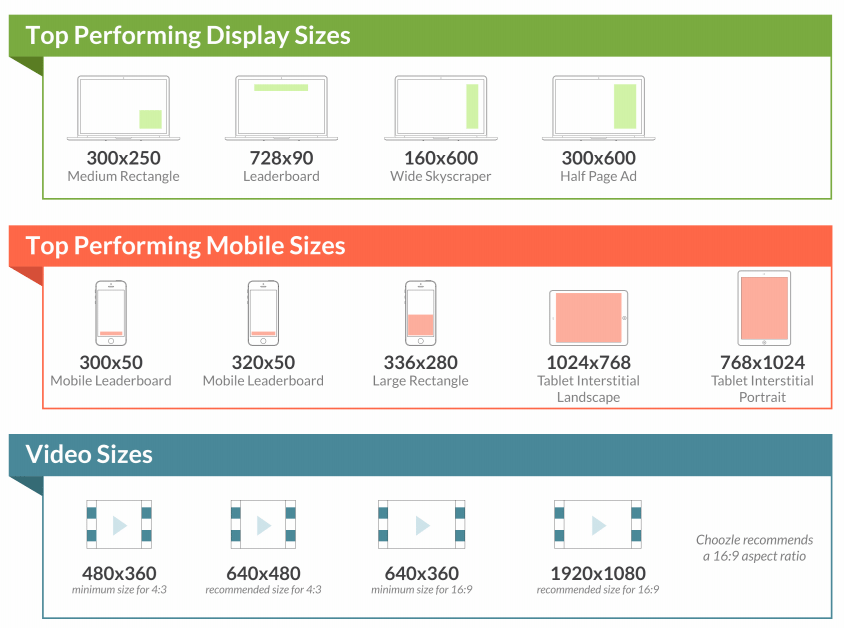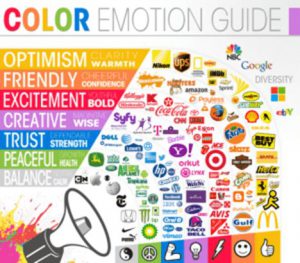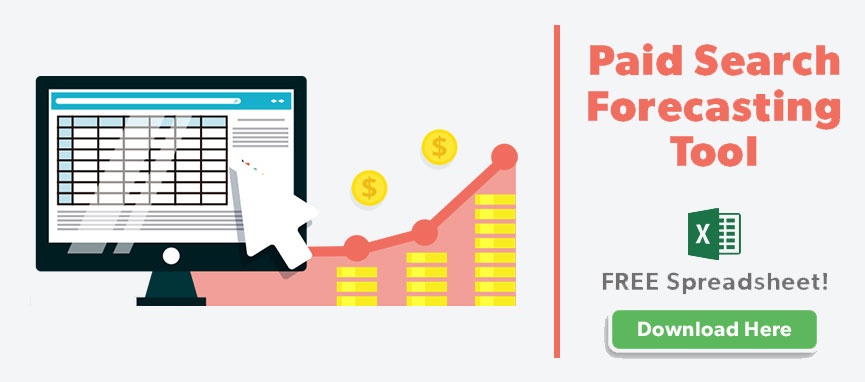DSP Display Creative Best Practices
One of the biggest challenges we face as marketers is when it comes to display advertisements — are we using the right platform? Are we reaching a large enough audience? Is our ad having an impact? Did we use the right font?
All of these questions and more run through our mind during the setup of a campaign. For good reason too. Successful advertising takes time, money and resources. So how can we be more confident in our choices? A common way to streamline the ad buying process is by using an automated ad buying system called Demand Side Platforms, or DSPs.
With the rise of digital advertising and the death of print, companies spend the majority of their marketing budget online nowadays. But there are some guidelines when it comes to creating a successful online ad. There’s also some recognized creative best practices that the industry agrees will yield the best results. When creating your ads for DSPs, it’s important to follow these industry standards and guidelines. But before we dive into that, we need to understand exactly what DSPs are and why we use them.
What are DSPs?
If DSPs were summed up in a newspaper headline it would be: ‘Salesman Replaced By Computer.’
There’s a little more to it than that, but that’s an easy way to understand DSPs. More technically speaking, a demand-side platform is a software that enables companies who buy digital advertising to manage and organize their ad exchange and data from a central interface. Rather than interacting with a person every time you need to buy ad space, you can make bids, change ads, and extract data all from one central hub.
DSPs primary job is something called programmatic media buying — DSP software chooses which impressions to buy based on targeting criteria defined by the advertising company. It’s a form of audience-based digital advertising as opposed to contextual targeting.
The ads you can bid on include, but are not limited to: display, video, mobile and search ads. Typically the bids are conducted in real-time ad exchange auctions. The ads appear across multiple sites, targeting users based on specific demographics selected by the bidders, such as age, gender, location, browsing history, etc. In other words, marketers are purchasing highly qualified digital impressions.
Why Use DSPs?
The most obvious reason is the amount of time you save. With the removal of sales people as the middleman, you erase human error and lengthy turn around times. For companies who have new initiatives frequently, and are constantly rotating out new creatives, DSPs are a game changer. Here are a couple more important reasons why DSPs are a popular choice:
- Wide access to a credible network of ad inventory
- Real-time bidding (can purchase within seconds)
- Vertical and lateral targeting
- Access to large inventory creates unique goals and opportunities for targeted marketing.
- DSPs allow for behavioral profiling, retargeting and frequency capping.
- A single interface allows for the most effective data measurement and ad impact management
- DSP technology is always improving, and the level of detail companies are able to track is also increasing. This results in the ability to dive deeper and deeper into ad optimization.
- Similar to paid search, DSPs allow companies to optimize based on key performance indicators.
- Transparency – Buyers know what they are getting and exactly the type of impressions they’re going to receive for the amount of money they are investing.
- Built-in budget managers have your best interests at heart. They factor in your campaign goals and budget, then assist you in making sound choices based on the value of each impression. In other words, better ROI.
- Reporting – When you need to get the metrics to the higher-ups, DSP’s real-time reporting and comprehensive tracking, streamlines that process.
Guidelines For Creating Ads
Being able to buy ad space within budget, for a targeted audience, in a matter of seconds, is great. But it doesn’t mean anything if you don’t have a great visual advertisement to go along with it. Unfortunately, DSP software isn’t much use on the creative side of things — it’s a broker, not an artist.
Display ads have a specific set of guidelines and specifications to follow in order for your ad to be accepted. The last thing you want to do is invest time, money and resources into a piece of creative only to have it rejected. Here are some rules and guidelines to follow for creative work:
- Individual display creatives cannot be larger than 300KB
- Acceptable file formats: GIF, JPEG, PNG, HTML5
- Choozle does not support flash creative anymore
- Creative images must be clear, relevant and easily recognizable
- Images cannot appear upside down or sideways
- Text must be legible
- There cannot be multiple copies of the same image within itself.
- Creative with a white or black background must have a border to separate it from the host website.
- The landing page of a creative must be relevant and open in a new page
- The max creative size is 300kb (this includes individual creatives in .ZIP)
Video Ads/In-Banner Creative:
- The max video size is 15MB
- Acceptable file formats: .MP4, .FLV, .WEBM, .MOV, .MPG, .MPEG, .OGG
- Click-to-start videos do not have a length limit, but the upon completion the video must go to the landing page
- Videos must contain standard controls: play, pause, mute/unmute
- Auto start videos – 15 second max play time, audio cannot play without mouse-over, and videos should be backstopped by a static 300×250 that clicks through to a landing page.
HTML5 Creatives:
- Acceptable file formats: .ZIP
- HTML5 .ZIP max file size is 10MB
- The .ZIP file must include the HTML for the ad and for these file types: .CSS, .JS, .HTML, .GIF, .PNG, .JPG, .JPEG, .SVG
- Nested folders are not allowed in .ZIP files, instead they must be located at the root level of the .ZIP archive file
- Animated ads have a max looping limit of 15 seconds, and then must become static.
Other .ZIP files:
- .ZIP files with individual creative have a max size limit of 100MB
Below is a chart with the most commonly used image and video dimensions.

Tips For Creating Great Display Ads
Creating ads is not an exact science — it can be a challenge to create the perfect imagery, animation, or video. You’ll never fully be able to guess the way customers are going to perceive things. However, since DSP ads are so heavily data driven, marketers are able to recognize creative successes, and pitfalls. Here are some tips to help get you inspired:
- Determine the purpose of the ad – is it to generate awareness or drive conversions? You want to tailor your ads to the different stages of the purchase funnel. For instance, if you’re retargeting a customer who has already shown interest, your ad should be different compared to if you were engaging with a cold customer.
- Think Mobile First – mobile display ads are now outpacing desktop, and 70.3% of all display ads are mobile, compared to 29.7% for desktop. Test your ads on mobile and make sure that their effectiveness translates to the smaller screen.
- Keep it simple — use one photo, one line of copy, and one CTA – use minimal writing that remains bold and well stated. Include a call-to-action that includes an element of value. For instance, if you’re a health food store — rather than ‘Buy Now’, your CTA should read ‘Buy now and get healthy’. Alternatively, you can take the more passive approach by including a ‘Learn More’ CTA. Just remember that simplified ads see the best results, and the more transparent your CTA, the better.
- Simple images — Follow the rule of thirds. It’s one of the most basic photography practices and it can make or break and image. It makes photographs easier on the eye and more distinguishable. Ad images should only take a second for the viewer to know what they’re looking at.
- Font – Limit your typography to two fonts per ad. You can highlight important information by making it bold. Limit the text within the ad to about 30% or less. Too much text can be overwhelming and most users will just gloss over it.
- Border — You don’t want people to miss your ad or mistake it for the host site’s native content. So throw enough border around your ad to clearly separate it from the host site.
- Sales & seasons — There’s usually always some sort of seasonal event or holiday around the corner. And as marketers, you have to be aware of these because they present unique opportunities to reach a bigger audience. Some examples of events to mold your ads around are: back to school, seasons, Olympics, Cyber Monday, the major holidays (Christmas, Halloween, Thanksgiving, etc.).
- Rich media ads – HTML 5 ads are increasingly popular, interactive and animated advertisements that stimulate higher levels of engagement.
- Color consistency – It can feel very misleading when you click on a link that takes you to a completely different looking website. While both may look good in their own regard, it’s much more important to have a consistent color scheme across your ad, and the website that it clicks-through to. This builds trust and shows brand strength.

- Color emotion guide — Big companies are very calculated in the way they choose their brand colors. That’s because they know the psychology behind it; each color on the spectrum evokes a different emotion. Choose colors that match the feeling you want your customers to have when they use your brand. Below is a color emotion guide to help get you started. Keep in mind, studies show that up to 90% of a person’s decision to buy comes down to color.
Wrapping Up
DSPs are taking online advertising optimization to the next level. You can buy ads, generate reports and manage precise budgets all from the same interface, and like most things now it happens in real-time. There are tons of benefits that come with using DSPs, but the most important is the targeted audience you’re able to hone in on. These are your potential customers, and you want to make an impact on them in an instant. But it’s hard to know exactly what’s going to resonate with your audiences. That’s why it’s crucial to follow common tips and tricks used by experienced marketers and creatives who have poured over the data to identify the best practices.



















